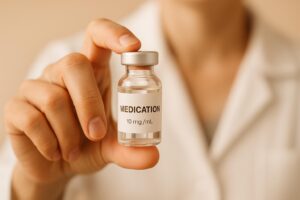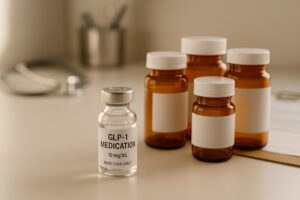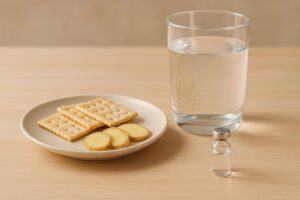GLP-1 Diet Plan: 7-Day Meal Guide
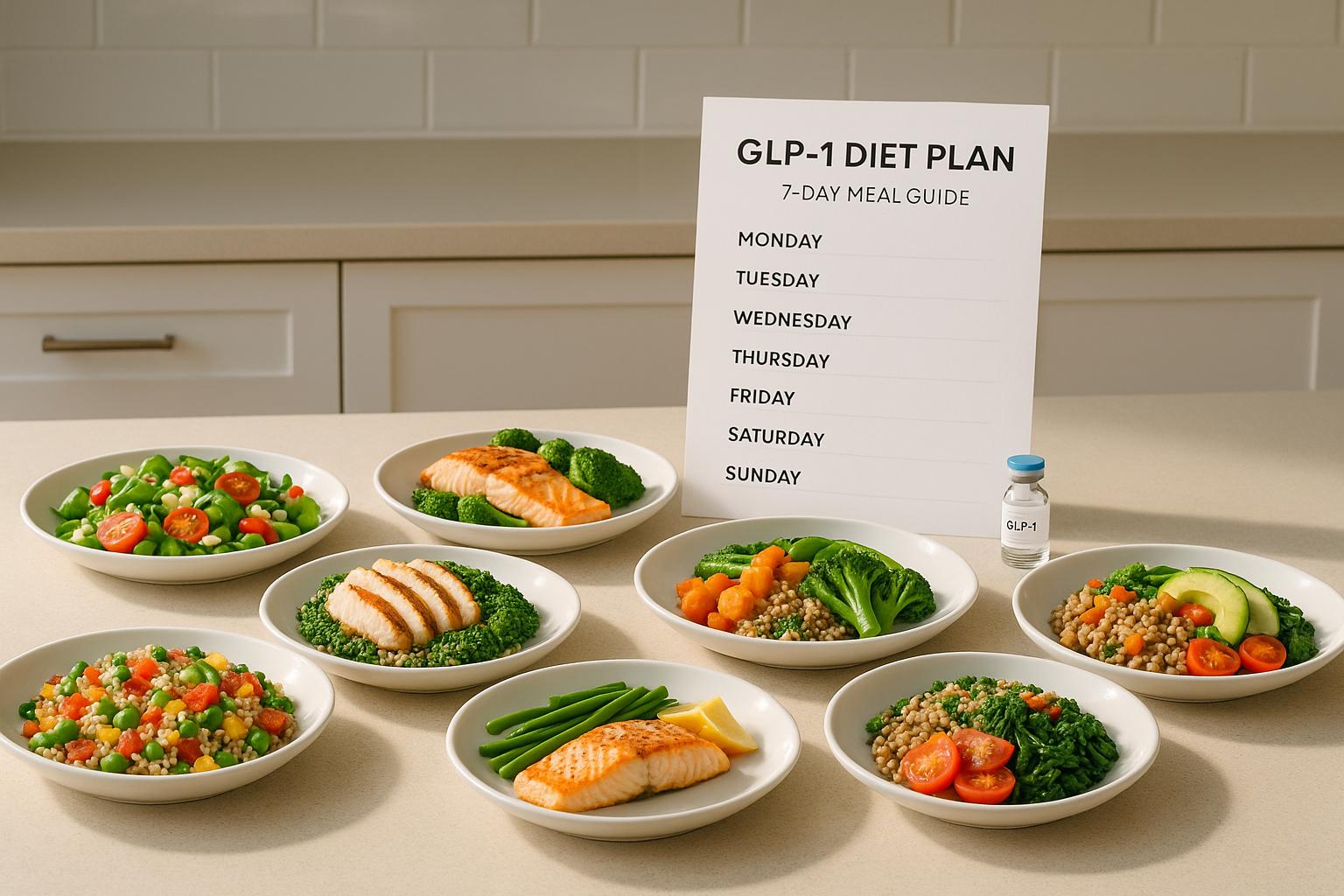
Starting a GLP-1 medication like Wegovy or Ozempic can aid weight loss, but success depends on pairing it with the right nutrition. These medications reduce appetite and slow digestion, so planning meals with protein, fiber, and smaller portions is key to avoiding side effects like nausea or constipation while maintaining muscle and energy levels.
Here’s what you need to know:
- Focus on protein: Aim for 25–30g per meal to preserve muscle and feel full longer.
- Add fiber: Women need 25g/day; men need 38g/day. Include whole grains, fruits, and vegetables.
- Eat smaller meals: Five to six meals every 2–3 hours work best with slower digestion.
- Balance your plate: Half veggies, a quarter lean protein, and a quarter complex carbs.
This 7-day meal plan offers practical, nutrient-rich ideas tailored for GLP-1 users to manage appetite, stabilize blood sugar, and support digestion. It includes tips for meal prep, hydration, and managing side effects to help you stay on track.
GLP-1 Medications and Nutrition Basics
How GLP-1 Medications Work
GLP-1 receptor agonists, such as Semaglutide (found in Ozempic, Wegovy, and Rybelsus), Liraglutide (Victoza, Saxenda), and Dulaglutide (Trulicity), mimic the natural GLP-1 hormone in the body. These medications help regulate blood sugar and support weight loss by increasing insulin release when needed, reducing the liver’s sugar production, and slowing digestion. This delay in digestion keeps food in the stomach longer, helping you feel full for a longer period.
Dual GIP/GLP-1 receptor agonists, like Tirzepatide (Mounjaro, Zepbound), target both receptors. These medications not only reduce appetite by acting on hunger-regulating areas in the brain but also help minimize food-related distractions, further lowering calorie intake. Studies show that GLP-1 medications can reduce calorie consumption by 16% to 39%. With Ozempic, for instance, users generally lose 10% to 15% of their body weight within six months to a year.
This explains why understanding and prioritizing nutrition is so important for achieving the best results.
Why Nutrition Matters for GLP-1 Users
Although GLP-1 medications are effective for weight management, they come with specific nutritional considerations. Since these drugs slow digestion and reduce appetite, it’s crucial to make every meal count by focusing on nutrient-rich foods to avoid deficiencies.
The right nutrition not only enhances the medication’s effectiveness but also helps reduce side effects. Protein plays a key role here – it supports muscle preservation during weight loss. Aim for 25–30 g of protein per meal. Excellent protein sources include fish, poultry, Greek yogurt, cottage cheese, legumes, and eggs.
Fiber is another essential component. Women should aim for 25 g of fiber daily, while men should target 38 g. Incorporate whole grains, beans, fruits, and vegetables to promote digestion and maintain stable blood sugar levels.
To avoid nausea or bloating, stick to smaller, more frequent meals instead of large portions. For those managing type 2 diabetes, maintaining steady blood sugar is critical. Pair high-fiber, complex carbohydrates – like quinoa, brown rice, and whole grains – with protein at each meal to prevent spikes and crashes.
GLP-1 Meal Planning Guidelines
Key Dietary Strategies
Design your meal plan to align with the way your medication affects hunger and digestion. Eating five to six smaller meals every 2-3 hours can help improve digestion and maintain your energy levels throughout the day.
Protein should always take center stage in your meals and snacks. Since your overall food intake is reduced, it’s important to make every bite count nutritionally. Start each meal with 3-4 oz of protein – think grilled chicken, Greek yogurt, or eggs. This approach not only supports muscle preservation during weight loss but also helps you feel full longer.
The plate method is a simple and effective way to ensure balanced nutrition. Picture your plate divided into sections: half should be non-starchy vegetables like broccoli, spinach, bell peppers, or zucchini. One quarter is for lean protein, and the last quarter is for complex carbohydrates such as sweet potatoes, quinoa, or brown rice. This visual guide keeps things straightforward without needing to measure everything.
Texture and temperature matter when it comes to digestion. Many GLP-1 users find that room temperature or slightly warm foods are easier to tolerate than very hot or cold dishes. Softer foods like smoothies, soups, and well-cooked vegetables are often gentler on the stomach during the early stages of adjustment.
Pairing carbohydrates with protein or healthy fats can also help regulate blood sugar levels. For example, try apple slices with almond butter or whole grain toast topped with avocado. Combining these dietary strategies with lifestyle changes can lead to better results overall.
Lifestyle Tips for Success
To complement your meal plan, these lifestyle adjustments can enhance your experience with GLP-1 medications.
Slow down while eating. Aim to spend 20-30 minutes on each meal, pausing between bites to let your body recognize fullness. Since the medication already enhances these signals, eating too quickly can lead to discomfort or even nausea.
Rethink your hydration habits. Drinking large amounts of water with meals can be uncomfortable. Instead, sip small amounts – about 4-6 oz – during meals, and focus on staying hydrated between them. Spread out your water intake, aiming for 64-80 oz daily, to avoid overwhelming your system.
Meal prep is your secret weapon for staying on track. Dedicate 2-3 hours on the weekend to prepare protein options, wash and chop vegetables, and portion out snacks. Having ready-to-eat meals and snacks on hand makes it easier to avoid processed foods when hunger strikes and helps you manage portion sizes effortlessly.
After meals, consider engaging in light physical activity like a 10-15 minute walk. This gentle movement supports digestion and can ease any discomfort. Avoid intense exercise right after eating, as it can be counterproductive, but a short stroll can work wonders.
Sleep plays a major role in your success. Poor sleep can lead to stronger cravings for sugary or high-fat foods and make it harder to stick to your eating routine. Aim for 7-9 hours of quality sleep each night, and try to finish your last meal at least 3 hours before bedtime to aid digestion.
Keeping a food journal can help you fine-tune your meal plan. Record what you eat, the portion sizes, the time, and any symptoms like nausea or discomfort. Over time, this can reveal patterns and help you adjust your meals to better suit your needs.
When it comes to social eating, planning ahead is key. Have a small, protein-rich snack before events to avoid arriving too hungry. If dining out, review restaurant menus in advance to identify suitable options. Don’t be afraid to request modifications, like getting dressings on the side or choosing grilled items over fried ones. These small steps can make a big difference in sticking to your plan.
7-Day GLP-1 Meal Guide
Daily Meal Plan Examples
This meal guide is designed to complement your GLP-1 medication by offering balanced, nutrient-rich options that align with a reduced appetite. Each meal is crafted to include 20–30g of protein, helping to maintain muscle and promote fullness.
Day 1: Start your morning with Huevos Divorciados (around 22g protein). For lunch, enjoy an Avocado Tuna Salad paired with a large pear, combining lean protein with healthy fats. Dinner features a One-Skillet Garlicky Salmon served alongside broccoli and brown rice, providing omega-3s and fiber-packed veggies.
Days 2–4: Breakfast could be Overnight Oats with Chia Seeds and ½ cup of nonfat Greek yogurt. For lunch, opt for a pre-made Creamy Chicken Florentine Casserole. Having these ready-to-eat meals ensures you’re prepared when hunger strikes.
Day 5: Try a flavorful dinner like Quick Gochujang Pork & Rice Bowls. If you prefer a milder dish, reduce the gochujang and substitute with a mix of low-sodium soy sauce and a teaspoon of honey.
For snacks throughout the week, consider options like Cottage Cheese–Berry Bowls, White Bean–Stuffed Mini Bell Peppers, Tzatziki Cucumber Slices with Blueberries, or ¼ cup of unsalted, dry-roasted pistachios. These snacks combine protein and fiber to keep you feeling satisfied.
Portion Sizes and Preparation Tips
Since GLP-1 medications often reduce appetite, you might notice your portion sizes naturally shrinking. Stick to the balanced plate model you’ve used before to guide your meals.
Meal prepping can make portion control easier. For example, prepare a double batch of Overnight Oats with Chia Seeds and store them in Mason jars for grab-and-go convenience. When making the Creamy Chicken Florentine Casserole, save extra servings for future lunches. Dining out? Consider ordering an appetizer as your main course or asking for a to-go box upfront, as restaurant portions are often oversized.
Feel free to adjust portions to suit your appetite and nutritional needs.
How to Customize Your Meal Plan
You can tweak these meal ideas to better fit your dietary preferences or restrictions while keeping them balanced. For a vegetarian option, swap out tuna salad for a Chickpea and Avocado Salad, or replace salmon with firm tofu or tempeh. If you’re avoiding dairy, use coconut yogurt instead of Greek yogurt and add an extra source of protein if needed.
Personalize your veggies too – substitute broccoli with asparagus, green beans, or Brussels sprouts while maintaining the overall nutritional balance.
If you experience nausea, especially on injection days, softer foods like a protein smoothie made with your Overnight Oats ingredients can be a gentler choice. You might also find it helpful to make lunch your largest meal of the day instead of dinner.
To save on groceries, consider using frozen vegetables, canned salmon, or buying proteins in bulk. This could trim $20–$30 off your weekly food bill.
Seasonal adjustments can also keep your meals interesting. In the summer, go for cool dishes like gazpacho or chilled cucumber soup. During winter, warm up with hearty meals like a chicken casserole or vegetable stew. Rotate fruits based on what’s in season – berries in summer, apples and pears in fall, or citrus fruits in winter.
[1] Adapted from EatingWell, "Simple 7-Day GLP-1-Friendly Meal Plan for Beginners, Created by a Dietitian", October 16, 2025.
Foods to Include and Avoid
Recommended Foods
When you’re using GLP-1 medications, the right food choices can make all the difference. Here are some options to prioritize:
Lean proteins like chicken breast, turkey, fish, eggs, tofu, and tempeh help maintain muscle and keep you feeling full. Greek yogurt is a standout choice because it not only packs protein but also contains probiotics to support your digestion.
Whole grains such as brown rice, quinoa, oats, and whole wheat bread are excellent for providing steady energy and keeping your blood sugar stable.
Non-starchy vegetables – think broccoli, spinach, bell peppers, zucchini, cauliflower, kale, and arugula – are high in fiber and nutrients. These veggies add bulk to your meals without overwhelming your appetite, which may be reduced due to the medication.
Healthy fats in moderation are essential for hormone function and nutrient absorption. Avocados, olive oil, nuts, and seeds are great options. For example, a tablespoon of olive oil or a small handful of nuts can boost meal satisfaction without upsetting your stomach.
Low-sugar fruits like berries, apples, pears, and citrus fruits are rich in fiber and vitamins. They help slow sugar absorption, which can be particularly helpful if you’re dealing with any GLP-1-related digestive sensitivity.
These food groups can work hand-in-hand with your medication to enhance its effects. But certain foods can have the opposite impact.
Foods to Limit or Avoid
Some foods can interfere with your progress or exacerbate side effects. Here’s what to watch out for:
High-fat, greasy foods can make nausea and stomach discomfort worse. Fried foods, fatty meats, and rich sauces – like fast food burgers, deep-fried chicken, or creamy pasta – may sit heavily in your stomach, especially when digestion slows.
Sugary foods and drinks can lead to blood sugar spikes and derail weight loss efforts. Candy, cookies, soda, and sweetened coffee drinks are full of empty calories. Even natural options like fruit juices lack the fiber of whole fruits and can still cause issues.
Highly processed foods often contain excess sodium and preservatives. Packaged snacks, frozen meals, and processed meats like hot dogs or deli slices may leave you unsatisfied despite their calorie content.
Carbonated beverages can cause bloating and discomfort, particularly when paired with GLP-1 medications’ effects on digestion. Even diet sodas, though calorie-free, may disrupt natural hunger signals and lead to digestive upset.
Oversized portions are another pitfall. With slower stomach emptying, large meals can lead to prolonged fullness and discomfort. Restaurant servings, which often contain two to three times the recommended portion size, can be especially challenging.
Food Choice Comparison
To help you make better decisions, here’s a quick comparison of recommended foods versus those to avoid:
| Recommended Foods | Benefits | Foods to Limit | Potential Issues |
|---|---|---|---|
| Grilled chicken breast | High in protein; easy to digest | Fried chicken | High fat content may worsen nausea and slow digestion |
| Greek yogurt with berries | Protein-packed and contains probiotics | Ice cream | High sugar and fat can cause blood sugar spikes and digestive discomfort |
| Brown rice | Fiber-rich complex carbs for steady energy | White bread | Refined carbs cause blood sugar fluctuations and are less satisfying |
| Olive oil (1 tbsp) | Healthy fats that aid nutrient absorption | Butter (multiple tbsp) | Excess saturated fats may increase nausea and calorie intake |
| Sparkling water with lemon | Hydrating and sugar-free | Regular soda | High sugar content counteracts weight loss goals |
| Baked salmon | Lean protein with omega-3s | Fish and chips | Breading and frying can lead to digestive issues |
Using these tips, you can build a daily meal plan that supports your GLP-1 therapy while keeping you nourished and comfortable.
sbb-itb-e2779c3
Tracking Progress and Making Adjustments
How to Track Your Intake and Progress
Once you’ve established a balanced meal plan, the next step is keeping tabs on your progress. For those using GLP-1 medications, tracking meals, weight, and body composition is key to effective weight loss. A food diary app can be your best friend here – use it to log meals and ensure you’re getting enough protein and fiber to protect muscle mass. Weigh yourself at the same time each day to observe trends over time.
If you have diabetes, keeping an eye on your blood sugar is critical. Check your HbA1c levels every three months to stay on top of things. Additionally, pay attention to your hunger cues – distinguish between genuine hunger and eating out of habit. This can help you fine-tune your meal timing and portion sizes.
Managing Side Effects
GLP-1 medications sometimes come with side effects like nausea, constipation, or heartburn. Tackling these issues can make a big difference in how you feel. Start by eating smaller, more frequent meals, slowly increasing your fiber intake, and drinking plenty of water throughout the day. If heartburn is a problem, try identifying and avoiding foods that trigger it. These small changes, combined with guidance from a healthcare professional, can make managing side effects much easier.
Getting Support from TrimRX
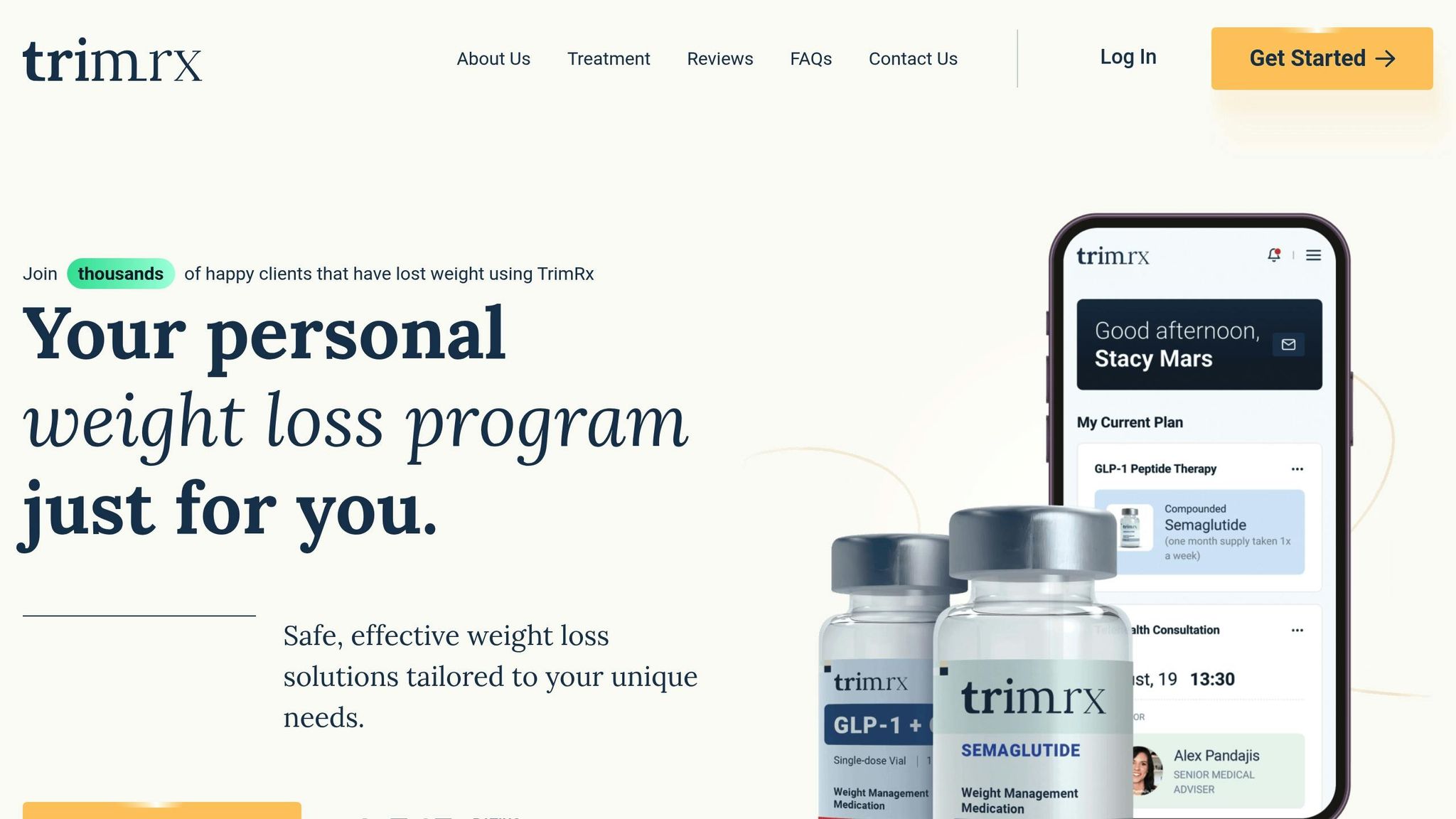
Monitoring your progress and making timely adjustments are essential for maximizing the benefits of your GLP-1 treatment. But you don’t have to navigate this journey alone. TrimRX offers a supportive, hands-on approach that goes beyond just providing medication. Through personalized consultations with their medical team, you can better understand how your medication interacts with your diet and identify reasons behind side effects or plateaus in your progress.
TrimRX also offers tailored dosing adjustments and unlimited check-ins to ensure your treatment stays aligned with your weight loss goals and dietary needs. Their GLP-1 Daily Support supplement is designed to help stabilize blood sugar, and with free delivery, you can maintain consistency with both your medication and meal planning.
What to eat on GLP-1 Medication: Effortless Meal Planning
Conclusion
A well-structured GLP-1 diet plan takes the guesswork out of weight loss and turns it into a clear, actionable strategy. The 7-day meal guide provided here focuses on balanced nutrition, portion control, and consistent meal timing to help you get the most out of your GLP-1 medication. It’s not just about following a plan – it’s about building a foundation for long-term success.
Pairing these habits with TrimRX’s personalized support can elevate your weight loss journey. Their approach includes tailored consultations and unlimited check-ins, ensuring you have the guidance you need every step of the way. By incorporating a routine filled with protein-rich meals, fiber-packed veggies, and mindful eating practices, you can better manage hunger, maintain stable blood sugar levels, and achieve steady progress. TrimRX’s Oral Semaglutide program, starting at $179, goes beyond medication to provide the comprehensive support you need to succeed.
If you’re dealing with challenges like nausea, portion control, or meal timing, having professional guidance can make all the difference. TrimRX’s personalized programs are designed to help you navigate these hurdles with confidence. With the right combination of medication, nutrition, and expert advice, achieving sustainable weight loss becomes a realistic goal.
FAQs
What are some tips to reduce nausea while following a GLP-1 diet plan?
Nausea is a common side effect of GLP-1 medications, but with a few tweaks to your diet and habits, you can often keep it in check. Start by eating smaller, more frequent meals throughout the day. Stick to foods that are light on fat, sugar, and processed ingredients. Steer clear of large portions or heavy, greasy dishes – they can make nausea worse.
Staying hydrated is another key step. Instead of gulping down large amounts of liquid at once, sip water or clear broths gradually throughout the day. If the queasiness lingers, try adding bland options like crackers, plain toast, or rice to your meals until you feel better. And, of course, if the nausea becomes severe or starts interfering with your daily life, reach out to your healthcare provider for guidance.
How can I meal prep effectively while following a GLP-1 diet plan?
Meal prepping can simplify sticking to your GLP-1 diet plan. Focus on meals rich in protein and fiber – these not only help keep you feeling full but also support stable blood sugar levels. Opting for smaller, more frequent meals can also help minimize any discomfort from slowed digestion.
Batch cooking is a smart way to stay prepared. Dishes like soups, stews, and casseroles can be made in advance, portioned out, and stored for the week. For quick snacks, keep options like pre-cut vegetables, hard-boiled eggs, or a handful of nuts within easy reach. By planning your meals ahead, you’ll always have healthy, balanced choices ready to go, making it easier to stay consistent with your goals.
How does the GLP-1 diet plan support stable blood sugar levels for people with type 2 diabetes?
The GLP-1 diet plan focuses on maintaining steady blood sugar levels by prioritizing nutrient-rich foods such as lean proteins, healthy fats, low-glycemic fruits, vegetables, and whole grains. These choices play a key role in managing glucose absorption and minimizing sudden blood sugar spikes.
Adding high-fiber foods and protein-packed options to meals and snacks can further enhance blood sugar stability. By slowing digestion and delivering lasting energy, this approach complements GLP-1 medications, promoting better glucose control and encouraging more balanced eating habits.
Related Blog Posts

Transforming Lives, One Step at a Time
Keep reading
Ultimate Guide to Semaglutide Dose Customization
This guide explores semaglutide dosing for diabetes and weight loss, emphasizing personalized adjustments for optimal results.
6 Common Drug Interactions with GLP-1 Medications
Learn about six common drug interactions with GLP-1 medications and how to manage potential risks for safe treatment.
Mounjaro Insurance Coverage: What to Know
Learn how insurance coverage for Mounjaro varies based on diabetes treatment and weight loss, along with tips for approval and cost-saving options.
Semaglutide vs. Tirzepatide: Max Dose
Explore the differences between two weight loss medications, their maximum doses, effectiveness, and safety profiles for better health outcomes.
Nausea and GLP-1 Medications: Solutions That Work
Learn effective strategies to manage nausea from GLP-1 medications, including dietary tips and the importance of personalized dosing.
5 Signs GLP-1 Medication Is Working for You
Learn the key signs that indicate your GLP-1 medication is effectively aiding weight loss, appetite control, and blood sugar management.
Plateau Problems: Restarting Weight Loss
Stalled weight loss on GLP-1 medications is common but manageable. Explore strategies to break through plateaus and regain momentum.
Body Fat Percentage Estimator – Know Your Stats
Estimate your body fat percentage in seconds with our free tool. Just input your height, weight, and more for instant results. Try it now!
Wegovy vs Ozempic: Complete Comparison
Explore the differences between two popular medications for weight management and diabetes, including dosing, side effects, and effectiveness.
